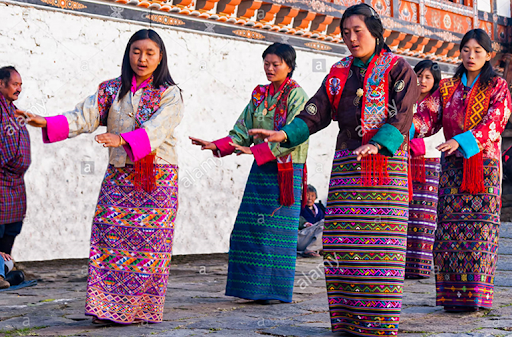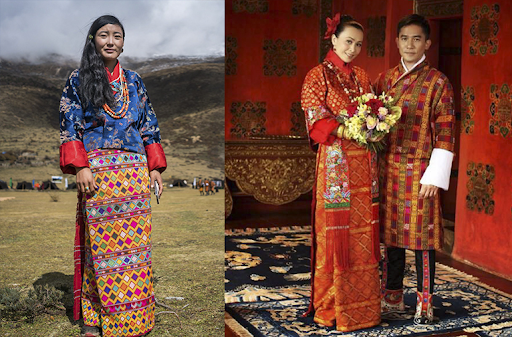To sign up for our daily email newsletter, CLICK HERE
Your Bhutan Tour Packages are enhanced by delighting yourself in the authentic Bhutanese cuisine at Babesa Village Restaurant while wearing and appreciating Bhutan’s Unique National Dress.
Bhutan, this tiny kingdom which is often referred to as the “Land of the Thunder Dragon”, is not just known for its stunning landscapes but also for its rich cultural heritage. The importance of traditional clothing in Bhutan goes far beyond fashion. It is an actual representation of the country’s principles, traditions, and history. Wearing traditional attire during formal events, holidays, or daily life is a way for Bhutan to show its dedication towards preserving its cultural legacy. Join us as we unravel the threads of Bhutan’s Unique National Dress.
Bhutan’s National Dress: Unveiling History, Symbolism & Importance
1. History of Bhutan’s Traditional Dress

Tradition, culture, and evolution, all of them are linked in the history of Bhutan’s unique national dress.
Its origins date back centuries and are connected with the early kings of the country and their relationships with neighbouring areas.
The traditional Bhutanese clothing, the Gho and Kira evolved as a result of historical developments, cultural exchanges, and the arrival of Buddhism.
Bhutan experienced the development of its national identity in the 17th century under the rule of Ngawang Namgyal, the first Druk Gyalpo (Dragon King).
Around this time, the Gho became the most common item of clothing for males, as a reflection of practicality given the harsh terrain and freezing climate of the Himalayas.
The Gho’s generous folds and loose fit made it easy to move around and stay warm in everyday life.
Bhutan’s unique national dress was further influenced by Buddhism, as indicated by the introduction of the Kira for ladies.
The Kira takes inspiration from Buddhist teachings and is a symbol of elegance and simplicity.
The Kira evolved into its current form over time, which can be identified by complex weaving techniques, vivid colours, and patterns.
Bhutanese traditional clothing has been surprisingly evolving with the times without losing its character despite these historical influences.
2. Types of Bhutan’s National Dress
The Gho is worn by males, and the Kira by women, these are the two main outfits that together make Bhutan’s Unique National Dress.
The Gho is a knee-length robe tied at the waist by a woven belt called a kera. It is usually made of cotton or silk.
The Kabney is a long scarf that is worn over the left shoulder and tied at the right waist to denote the wearer’s social class and rank which completes the costume.
The Kira, on the other hand, is an ankle-length dress with elaborate patterns and decorations.
The Kira is made of handwoven fabric that displays Bhutanese weaving traditions, every single item of clothing reflects the artistry and skill of Bhutanese designers.
The Kira is worn with a Tego, a short jacket, over the dress, and a Wonju, a blouse worn below.
These elements come together to form a stunning combination that perfectly portrays the grace and elegance of Bhutan’s women.
Every component of Bhutan’s unique national dress has a symbolic meaning that reflects the identity, values, and beliefs of the people of Bhutan.
From the Kabney’s colours that signify social standing to Kira’s designs that represent wealth and good fortune, every element of the clothing has unique significance and history,
3. Meanings of Symbols and Patterns

Bhutan’s unique national dress reflects the country’s rich cultural legacy and spiritual tradition, serving as more than just a piece of clothing.
The fabric’s woven patterns, colours, and designs have multiple meanings that are derived from Bhutanese customs and beliefs.
Particular meaning is attached to the colours of the Gho and Kira, each of which represents different aspects of spirituality.
For example, red is connected to strength and energy, and white to purity and peace. Green, on the other hand, denotes fertility and harmony with nature, while yellow stands for authority and success.
Bhutan’s Unique National Dress has patterns and designs that have deeper meanings in addition to colour symbolism.
In Bhutanese culture, symbols like the endless knot, lotus flower, and dragon are considered sacred and stand for concepts of protection, enlightenment, and connectivity.
In Bhutan, dressing traditionally is a spiritual and cultural practice as much as an aesthetic choice.
In rituals and ceremonies, wearing the Gho or Kira expresses respect for the values it represents and respect for tradition.
4. Importance and Evolution
The significance of Bhutan’s traditional dress remains unchanged in an ever-changing world.
Bhutanese people keep wearing their traditional clothing as a sign of identity, pride, and cultural legacy despite the effects of modernization and globalization.
Particularly the younger generation is important for preserving and improving Bhutanese traditional attire.
To preserve their legacy for future generations, younger generations are actively participating in events like fashion shows, cultural festivals, and educational projects, and proudly showcasing their national identity.
Bhutan’s Unique National Dress continues to fascinate people worldwide, promoting a deeper respect and understanding of Bhutanese culture, from political engagements to fashion trends.
As the country moves toward modernity, Bhutan’s unique national dress serves as an emblem of tradition and reminds its citizens of the principles that connect them.
Conclusion
Beyond just being an attire, Bhutan’s Unique National Dress holds great significance. It connects people to their history and promotes a feeling of shared belonging by serving as an actual expression of Bhutanese identity.